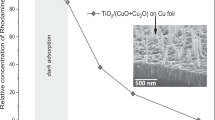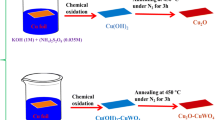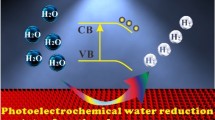Abstract
CuO is an attractive photocatalytic material for water splitting due to its high earth abundance and low cost. In this paper, we report the deposition of CuO thin films by sol–gel dip-coating process. Sol deposition has attractive advantages including low-cost solution processing and uniform film formation over large areas with a fairly good control of the film stoichiometry and thickness. Pure CuO phase was obtained for calcination temperatures higher than 360 °C in air. The CuO photocurrents for hydrogen evolution depend on the crystallinity and the microstructure of the film. Values of −0.94 mA cm−2 at pH = 8 and 0 V vs. RHE were achieved for CuO photoelectrodes annealed at 400 °C under air. More interestingly, the stability of the photoelectrode was enhanced upon the sol–gel deposition of a TiO2 protective layer. In this all sol–gel CuO/TiO2 photocathode, a photocurrent of −0.5 mA cm−2 is achieved at pH = 7 and 0 V vs. RHE with a stability of ~100% over 600 s.

Highlights
-
Sol–gel-based CuO photoelectrode has values of −0.94 mA cm−2 at pH = 8 and 0 V vs. RHE.
-
CuO/TiO2 photoelectrodes have been synthesized by the sol–gel chemistry coupled with dip-coating.
-
These photoelectrodes exhibit −0.5 mA cm−2 at pH = 7 and 0 V vs. RHE.
-
These photoelectrodes are 100% stable over 600 s.






Similar content being viewed by others
References
Dudley B (2014) BP Energy Outlook 2035. BP’s Energy Outlook 94:1-7.
Lewis NS, Nocera DGL (2006) Powering the planet: chemical challenges in solar energy utilization. PNAS 103(43):15729–15735
Yilanci A, Dincer I, Ozturk HK (2009) A review on solar-hydrogen/fuel cell hybri energy systems for stationary applications. Prog Energy Combust Sci 35(3):231–244
Fujishima A, Honda K (1972) Electrochemical photolysis of water at a semiconductor electrode. Nature 238:37–38
Van de krol R (2012) Principles of photoelectrochemical cells. In: van de Krol R, Grätzel M(ed) Photoelectrochemical hydrogen production. electronic materials: science & technology. Springer, Boston, MA, Boston, p 13–67. Vol. 102
Wadia C, Alivisatos AP, Kammen DM (2009) Materials availability expands the opportunity for large-scale photovoltaics deployment. Environ Sci Technol 43(6):2072–2077
Dincer I (2002) Technical, environmental and exergetic aspects of hydrogen energy systems. Int J Hydrog Energ 27(3):265–285
Bhat SSM, Jang HW (2017) Recent advances in bismuth-based nanomaterials for photoelectrochemical water splitting. Chemsuschem 10(15):3001–3018
Abdi FF, Berglund SP (2017) Recent developments in complex metal oxide photoelectrodes. J Phys D-Appl Phys 50(19):22
Courtin E, Baldinozzi G, Sougrati MT, Stievano L, Sanchez C, Laberty-Robert C (2014) New Fe2TiO5-based nanoheterostructured mesoporous photoanodes with improved visible light photoresponses. J Mater Chem A 2(18):6567–6577
Hamd W, Cobo S, Fize J, Baldinozzi G, Schwartz W, Reymermier M, Pereira A, Fontecave M, Artero V, Laberty-Robert C, Sanchez C (2012) Mesoporous alpha-Fe2O3 thin films synthesized via the sol-gel process for light-driven water oxidation. Phys Chem Chem Phys 14(38):13224–13232
Iandolo B, Wickman B, Zoric I, Hellman A (2015) The rise of hematite: origin and strategies to reduce the high onset potential for the oxygen evolution reaction. J Mater Chem A 3(33):16896–16912
Sivula K, Le Formal F, Gratzel M (2011) Solar water splitting: progress using hematite (alpha-Fe2O3) photoelectrodes. Chemsuschem 4(4):432–449
Hilliard S, Baldinozzi G, Friedrich D, Kressman S, Strub H, Artero V, Laberty-Robert C (2017) Mesoporous thin film WO3 photoanode for photoelectrochemical water splitting: a sol-gel dip coating approach. Sustain Energy Fuels 1(1):145–153
Hilliard S, Friedrich D, Kressman S, Strub H, Artero V, Laberty-Robert C (2017) Solar-water-splitting BiVO4 thin-film photoanodes prepared by using a sol-gel dip-coating technique. ChemPhotoChem 1(6):273–280
Song J, Cha J, Lee MG, Jeong HW, Seo S, Yoo JA, Kim TL, Lee J, No H, Kim DH, Jeong SY, An H, Lee BH, Bark CW, Park H, Jang HW, Lee S (2017) Template-engineered epitaxial BiVO4 photoanodes for efficient solar water splitting. J Mater Chem A 5(35):18831–18838
Paracchino A, Laporte V, Sivula K, Gratzel M, Thimsen E (2011) Highly active oxide photocathode for photoelectrochemical water reduction. Nat Mater 10(6):456–461
Yoon SKM, Kim IS, Lim JH, Yoo B (2014) Manipulation of cuprous oxide surfaces for improving their photocatalytic activity. J Mater Chem A 2:11621–11627
Lin CY, Lai YH, Mersch D, Reisner E (2012) Cu2O|NiOx nanocomposite as an inexpensive photocathode in photoelectrochemical water splitting. Chem Sci 3:3482–3487
Paracchino A, Brauer JC, Moser JE, Thimsen E, Graetzel M (2012) Synthesis and characterization of high-photoactivity electrodeposited Cu2O solar absorber by photoelectrochemistry and ultrafast spectroscopy. J Phys Chem C 116(13):7341–7350
Zhang Z, Wang P (2012) Highly stable copper oxide composite as an effective photocathode for water splitting via a facile electrochemical synthesis strategy. J Mater Chem 22:2456
Zhang Z, Dua R, Zhang L, Zhu H, Zhang H, Wang P (2013) Carbon-layer-protected cuprous oxide nanowire arrays for efficient water reduction. ACS Nano 7:1709–1717
Lim YF, Chua CS, Lee CJ, Chi D (2014) Sol-gel deposited Cu2O and CuO thin films for photocatalytic water splitting. Phys Chem Chem Phys 16:25928–25934
Jin Z, Zhang X, Li Y, Li S, Lu G (2007) 5.1% Apparent quantum efficiency for stable hydrogen generation over eosin-sensitized CuO/TiO2 photocatalyst under visible light irradiation. Catal Commun 8:1267–1273
Liu ZBH, Xu S, Sun DD (2011) Hierarchical CuO/ZnO “corn-like” architecture for photocatalytic hydrogen generation. Int J Hydrog Energ 36(21):13473–13480
Pai YHF, Fang SY (2013) Preparation and characterization of porous Nb2O5 photocatalysts with CuO, NiO and Pt cocatalyst for hydrogen production by light-induced water splitting. J Power Sources 230:321–326
Paracchino A, Mathieu N, Hisatomi T, Stefik M, Tilley SD, Graetzel M (2012) Ultrathin films on copper(I) oxide water splitting photocathodes: a study on performance and stability. Energy Environ Sci 5:8673–8681
Morales-Guio CG, Tilley SD, Vrubel H, Gratzel M, Hu XL (2014) Hydrogen evolution from a copper(I) oxide photocathode coated with an amorphous molybdenum sulphide catalyst. Nat Commun 5:1-96.
Hench L, Hench, West JK (1990) The sol-gel process. Chem Rev 90(1):33–72
Jia QX, McCleskey MTM, Burrell AK, Lin Y, Collis GE, Wang H, Li Q, Foltyn SR (2004) Polymer-assisted deposition of metal-oxide films. Natture Mater 3:529–532
Ray SC (2001) Preparation of copper oxide thin film by the solègel like dip technique and study of their structural and optical properties. Sol Energy Mater Sol Cells 68(3-4):307–312
Grosso D, Soler-Illia G, Crepaldi EL, Cagnol FF, Sinturel C,C, Bourgeois A, Brunet-Bruneau A, Amenitsch H, Albouy PA, Sanchez CN (2003) Highly porous TiO2 Anatase optical thin films with cubic mesostructure stabilised at 700°C. Chem Mater 15(24):4562
Patterson AL (1939) The scherrer formula for X-ray particle size determination. Phys Rev 56(10):978–982
Koshy J, Goerge KC (2015) Annealing effects on crystallite size and band gap of CuO nanoparticles. Int J Nanosci Nanotechnol 6(1):1–8
Habibi MH, Bahareh B (2014) Effect of annealing temperature on crystalline phase of copper oxide nanoparticle by coppe acetate precursor and sol-gel method. J Therm Anal Calorim 115(1):419–423
Nakaoka K, Ueyama J, Ogura K (2004) Photoelectrochemical behavior of electrodeposited CuO and Cu2O thin films on conducting substrates. J Electrochem Soc 151:C661–C665
Kidowaki HO, Akiyama T, Suzuki A, Jeyadevan B, Cuya J (2012) Fabrication and Characterization of CuO-based solar cells. J Mater Sci Res 1(1):138–143
Johan MR, Suan MSM, Hawari NL, Ching HA (2011) Annealing effects on the properties of copper oxide thin films prepared by chemical deposition. Int J Electrochem Sci 6:6094–6104
Choudhary S, Solanki A, Upadhyay S, Singh N, Satsangi VR, Shrivastav R, Dass S (2013) Nanostructured CuO/SrTiO3bilayered thin films for photoelectrochemical water splitting. J Solid State Electrochem 17(9):2531–2538
Zhang ZH, Wang P (2012) Highly stable copper oxide composite as an effective photocathode for water splitting via a facile electrochemical synthesis strategy. J Mater Chem 22(6):2456–2464
Ma Q-B, Hofmann JP, Litke A, Hensen EJM (2015) Cu2O photoelectrodes for solar water splitting: tuning photoelectrochemical performance by controlled faceting. Sol Energy Mater Sol Cells 141:178–186
Siripala W, Ivanovskaya A, Jaramillo TF, Baeck S-H, McFarland EW (2003) A Cu2O/TiO2heterojunction thin film cathode for photoelectrocatalysis. Sol Energy Mater Sol Cells 77(3):229–237
Rokhmat M, Wibowo E, Sutisna, Khairurrijal, Abdullah M (2017) Performance improvement of TiO2/CuO solar cell by growing copper particle using fix current electroplating method. Procedia Eng 170(Supplement C):72–77
Zainun AR, Tomoya S, Mohd Noor U, Rusop M, Masaya I (2012) New approach for generating Cu2O/TiO2 composite films for solar cell applications. Mater Lett 66(1):254–256
Wang P, Wen X, Amal R, Ng YH (2015) Introducing a protective interlayer of TiO2 in Cu2O-CuO heterojunction thin film as a highly stable visible light photocathode. RSC Adv 5(7):5231–5236
Toupin J, Strub HP, Kressmann S, Boudot M, Artero V, Laberty C (2017) Engineering n-p junction for photo-electrochemical hydrogen production. Phys Chem Chem Phys.
Acknowledgements
This work was supported by the ANRT, the Agence Nationale de la Recherche through the LabEx ARCANE programme (ANR-11-LABX-0003-01), and Total-Energie Nouvelle.
Author information
Authors and Affiliations
Corresponding author
Ethics declarations
Conflict of interest
The authors declare that they have no conflict of interest.
Supplementary Information
Rights and permissions
About this article
Cite this article
Toupin, J., Strubb, H., Kressman, S. et al. CuO photoelectrodes synthesized by the sol–gel method for water splitting. J Sol-Gel Sci Technol 89, 255–263 (2019). https://doi.org/10.1007/s10971-018-4896-3
Received:
Accepted:
Published:
Issue Date:
DOI: https://doi.org/10.1007/s10971-018-4896-3




